How To Store Produce + Seasonal Produce Guide

How easy would life be if every piece of produce came with instructions on how to store them and when they're ready to eat? Unfortunately, that is not the case and you may still wonder whether or not bananas belong in the fridge.
To make your life easier, we put together this guide that will help you prolong the shelf life of your produce and buy the freshest fruits and vegetables all year round!
How To Store Fruit
Storing fruit properly not only keeps it fresh longer, it also maximizes the flavor! Most fruit will last longest in the crisper drawer of your fridge, however there are some fruits like pears or stone fruit (e.g. nectarines and apricots) that continue to ripen after they're harvested and should be stored at room temperature to develop a better flavor.
If you're worried about fruit flies, check out our guide on how to get rid of them!
Berries
Berries are delicate fruits. Since you usually buy them in bulk and oftentimes don't finish them all in one sitting, it's best to store them in the fridge unwashed.

Strawberries are best stored in a tightly closed glass jar. This way, the berries can last up to three weeks with little signs of spoilage. Leave the berries as is (don't remove the leaves) and don't wash them as moisture can quickly cause them to mold. Also, check for any strawberries that seem riper than others or that already have signs of mold so you can separate them from the ones you're planning to store.
Blueberries, raspberries, and blackberries should also go straight in the fridge without being washed. You can keep these in the container they came in and should pick a spot in the fridge where they won't get too cold and you can see them easily. Only wash berries you plan to eat within the next day or two to avoid mold.
Kiwis should sit on your countertop in a place where they're not exposed to direct sunlight. This will help them stay fresh for up to a week and help them complete the ripening process. Once they are ready to eat, you can store them in the fridge to stop the process and still enjoy the juicy fruit a few days later.
Passion fruit will stay fresh for up to two weeks at room temperature. When the fruit is ripe you should store it in a paper bag in the fridge and eat it within two days. By the way, passion fruit seeds and pulp can last up to three months in the freezer!
Grapes are happiest in the back of the fridge where they can stay cool -- just don't forget about them! You should store grapes in the original bag and keep them away from smelly foods like cheese or leek because they can absorb the odors and change their taste. As with the other berries, only wash them when you plan to eat them right after.
Citrus Fruit
Citrus fruit is great to jazz up a drink on a hot summer day or to support your immune system during the winter. These fruits last longest in the fridge but there are some additional hacks you can try to prolong their lifetime even further.
Lemons and limes can last up to a full month when you store them in a sealed bag or container in your crisper drawer. Compared to that, lemons or limes that sit on your countertop at room temperature can start to harden after only a week. So unless you plan to consume these citrus fruits within a few days, keep them cool!
Grapefruits will also last longest if you store them in the crisper drawer of your fridge. Cut grapefruits should be covered with plastic wrap (or a more eco-friendly alternative like beeswax wraps) and go back in the fridge so they remain fresh and juicy until you eat them.
Oranges and mandarins will keep fresh in your crisper drawer for at least two weeks. When stored at room temperature, oranges should be consumed within a couple of days and mandarins will last about one week.
Stone Fruit
Most stone fruit continues to ripen after it's harvested, which is why you should store it according to its ripening stage. Generally speaking, ripe fruit should be stored in the fridge, and fruit that isn't ready to eat yet will ripen quicker stored at room temperature. You can even speed up the ripening process by placing stone fruit in a sealed paper bag on the countertop. Read more information about storing stone fruit below.

Nectarines and peaches take about three days to ripen at room temperature. Ripe fruits should last up to a week in your crisper drawer.
Plums will keep fresh in your crisper drawer for up to five days. If you store plums on your countertop, you should eat them within a couple of days as they are quick to perish.
Apricots will ripen in about two to five days on the countertop. You can pack ripe apricots in a plastic bag and store them in your crisper drawer for about five days.
Cherries should always be stored in the fridge where they will keep for up to a week. Their ripening process stops after they're harvested so they will rot if they sit on your countertop for too long.
Pome Fruit
Apples and pears are the perfect Fall fruit. Although they're both in the pome fruit family, they prefer different environments for storage.
Apples can stay fresh for up to one month when you keep them in the crisper drawer of your fridge. Because this fruit emits the gas ethylene which speeds up the ripening and decaying process, you should always store them separately from other fruits.
Pears ripen from the inside out. This is important to remember so you can store them properly according to their ripening stage. Ripe pears will keep fresh in the fridge for up to five days. To speed up the ripening process of pears, place them in a paper bag at room temperature. The bag will trap the ethylene and speed up the ripening process!
Tropical Fruit
Unless you live in a tropical climate, most of this fruit will likely never be in season for you. Nevertheless, it's delicious and a great way to extend your palette. If you want to be mindful of your carbon footprint and household spending, try to limit your consumption and only buy as much as you'll be able to eat.
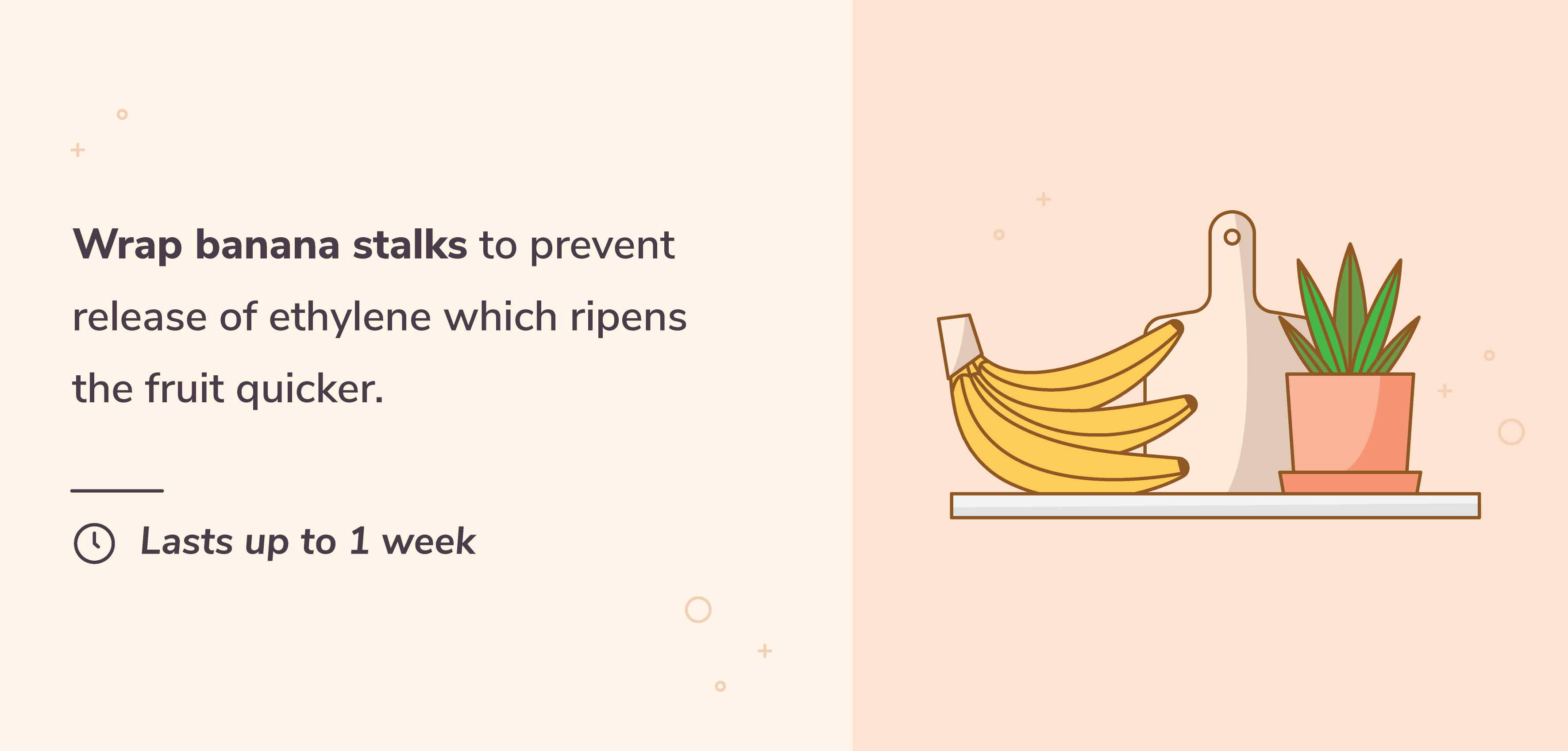
Bananas release ethylene (ripening gas) through their stalks. Wrapping the stalks up with cling film or plastic foil can keep the bananas fresh for longer. Store unripe or ready-to-eat bananas on your countertop. Hanging them from a banana rack will prevent bruising. Half-eaten or ripe bananas can be stored in the fridge so they don't go bad. While they may turn brown, this shouldn't affect the flavor of the fruit. If you've waited too long and your bananas have turned too brown for you to eat, make banana bread or pop them in the freezer for a smoothie down the road!
Mangoes that are mostly green need about a week to ripen at room temperature. Once ripe, you can keep mangoes in the fridge for another week before they perish. You can tell if your mangoes are ready to eat by gently pressing on them. If they emit a sweet scent, they're ready!
Pineapple is best stored at room temperature on your countertop. If you'd like to increase the acidity of the fruit, let it stand for a couple of days before slicing it up. Cut pineapple can last in your fridge for up to five days in a sealed bag or container.
Papayas can be difficult to judge. Unless the fruit is ripe, which you can tell by gently pressing the skin (a ripe papaya will give), it's best to store it at room temperature and turn it daily until it is ready to eat. In the fridge, a ripe papaya will last for a maximum of two days before it starts losing its flavor.
Melons
Melons are the perfect summer fruit! They're juicy, fresh, and ideal to share with friends or family. You can even freeze them for an all-natural popsicle that will help combat the summer heat.
Watermelons stop ripening after they're harvested. You can store a watermelon in the fridge for up to two weeks. If you don't have room to store a whole watermelon, cut it and store the pieces in a container. This way, you'll have refreshing and delicious watermelon to snack on for a full week!
Honeydew and cantaloupe will last in the fridge for up to five days when ripe. Unripe melons can sit on the countertop for up to two weeks until they're ready to cut and consume. You can check if the melons are ripe by gently pressing on the stem end. If the melons give off a sweet scent, they're ready to eat! Cut honeydew or cantaloupe will stay fresh in a container in your fridge for up to three days.
Other Fruit
Although you may not consider avocados or tomatoes fruit, by definition, they are! Check out how to keep them fresh and delicious by storing them correctly.
Avocados are famous for being rock hard for days and perishing within minutes. Check the firmness of your avocados before deciding how to store them. Firm avocados should sit on your countertop where they will last up to a full week as they ripen. Ripe avocados can sit in your fridge for up to five days before they turn brown on the inside. You can keep cut avocados fresh by squirting some lime or lemon juice on them and wrapping the fruit tightly in a food wrap.

Tomatoes are best stored on your counter so they can continue to ripen before you eat them. Storing tomatoes in the fridge may prolong their life but can dull the flavor.
How To Store Vegetables
Opening your fridge door to an abundance of colorful and fresh vegetables is a great feeling! However, not all veggies are meant to be stored in a cold environment. Check out how to store different vegetables so they stay fresh and keep their rich flavor.
Leafy Greens
Whether you toss them in a salad or use them to add some crunch to your sandwich -- leafy greens add freshness to many dishes. They also boost your productivity! To keep these delicate vegetables fresh, it's important to store them properly.
Lettuce needs a very specific amount of airflow and moisture to stay fresh. A little too much and it will get moldy, too little, and it will wilt. You can store a full head of lettuce in a plastic bag or container with a damp paper towel in your crisper drawer. This should help keep the balance it needs. A cut head of lettuce will also keep best in the fridge with a damp paper towel. To revive wilted lettuce, place it in a covered ice bath for 30-60 minutes. It brings the greens back to life!

Spinach is best stored in a container with a few dry sheets of paper towels to suck out the moisture that causes mold. You can transfer your spinach into a glass or plastic container or just keep them in the one they came in. Swap out the paper towels for fresh ones every couple of days and your spinach should last up to a week in the crisper drawer of your fridge.
Chard, also known as silverbeet or beet spinach, needs a bit of moisture just like lettuce. Loosely wrap it in a damp paper towel and store it in an unsealed bag in your crisper drawer. Chard should last up to a full week this way.
Marrow
Unlike other vegetables, you can wash marrow before storing it. As long as you fully dry these veggies, they won't perish any quicker.
Cucumbers need to be refrigerated but prefer a warmer spot near the front of your crisper drawer or even on the door. Cut cucumbers can last up to a week in a sealed container filled with water to prevent them from drying out.
Zucchinis and squash will last up to two weeks in your crisper drawer. Place them in a paper or plastic bag and leave the end open so air can circulate.
Pumpkins need to stay cool but you should only put it in the fridge when it's already cut. Whole pumpkins will last up to four months when stored upside down in a dark and cool place like your garage or basement.
Edible Plant Stems
We eat most of the vegetables without their stems. While they aren't usually poisonous, they're just not very tasty. However, certain plant stems are edible and rather delicious!

Asparagus can stay fresh in your refrigerator for up to a week. Store it upright in a glass or mug with water so it stays hydrated. You can refresh the water every couple of days to prolong the lifetime of these edible stems even further.
Celery can last up to two weeks when wrapped in a damp paper towel and stored in your crisper drawer in a plastic bag. You can also peel and cut celery and store it in a sealed jar or container filled with water. This will keep the vegetable fresh for about a week and give you easy access to a quick and healthy snack.
Root Vegetables
It's no surprise that root vegetables prefer dark places. If you eat a lot of root vegetables, invest in a wire mesh or natural fiber bin where you can store them properly. These baskets ensure proper air circulation which will prolong the life of your root vegetables.
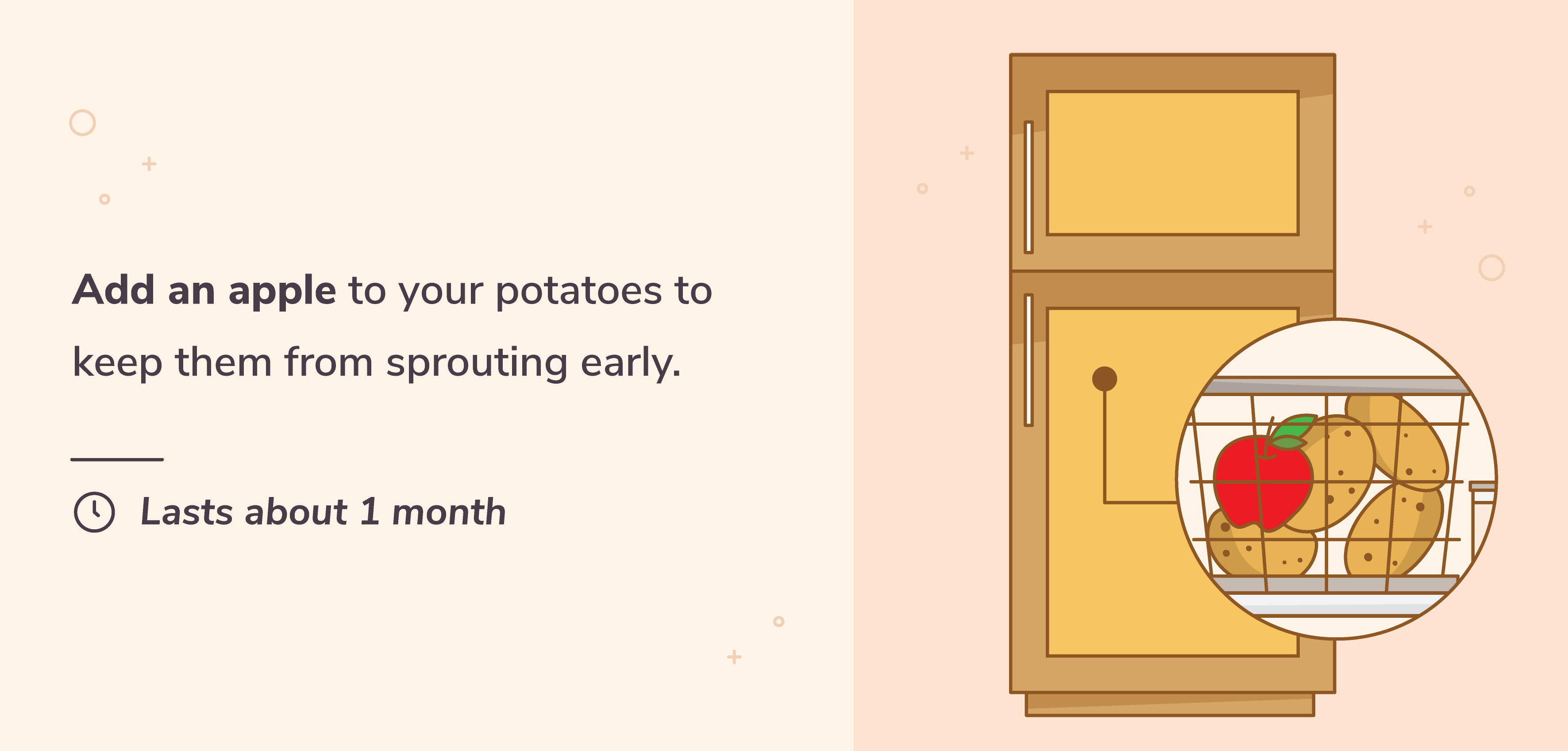
Potatoes keep best in a dry and dark place like your basement, garage, or pantry. Store them in a wire basket or open paper bag to allow for airflow. Keep them away from onions as they promote early sprouting. You can also add an apple to the bag which will prevent the potatoes from sprouting too early.
Yams and sweet potatoes should also be stored in a well-ventilated and dark place. Keeping them in the fridge will make the center of the vegetable hard and create an unpleasant taste.
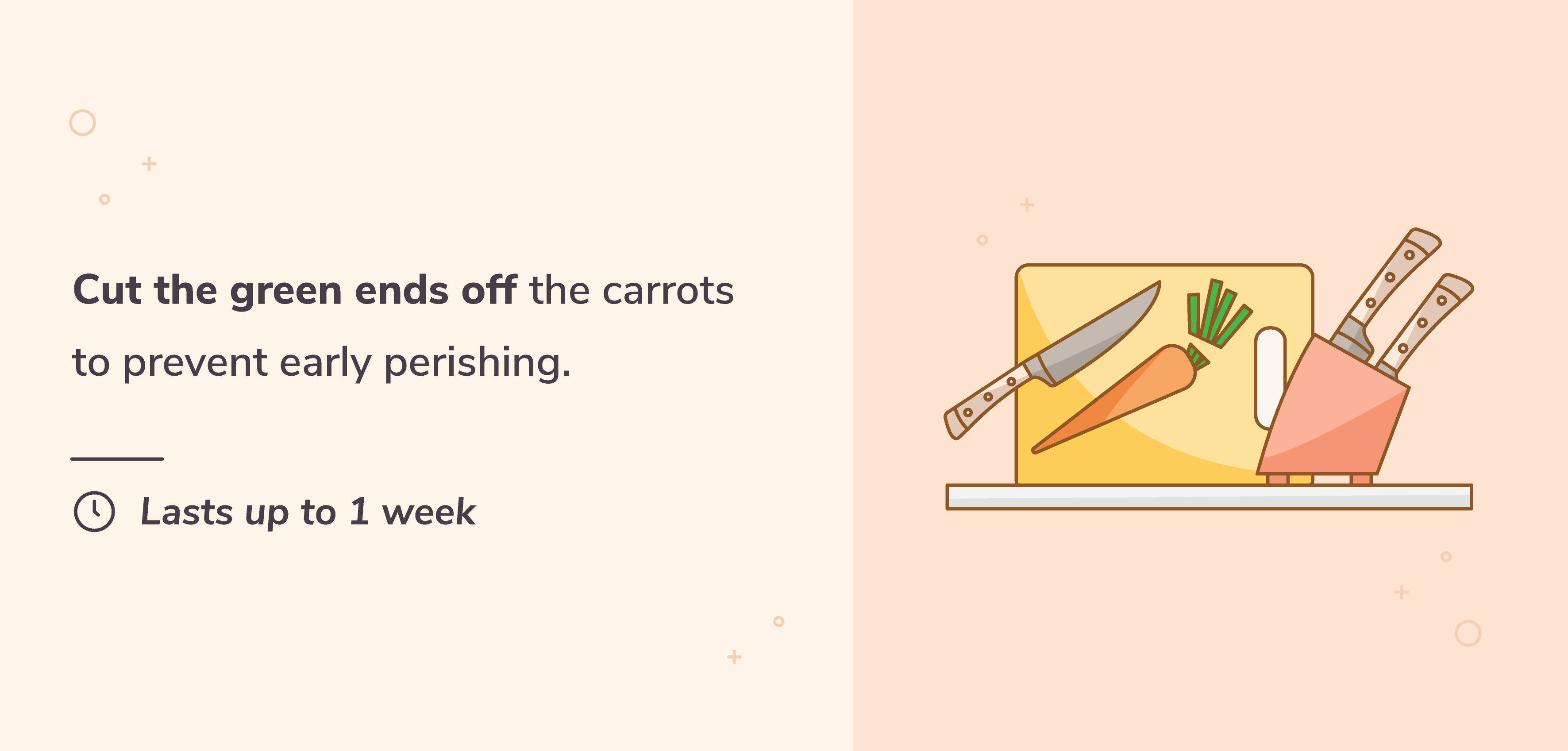
Carrots last longer when you cut off the green tops before storing them in your crisper drawer. If you like to snack on carrots all week long but don't feel like cutting them daily, try prepping them! Peel the carrots and cut them into sticks that fit into a mason jar (or similar glass container). Fill the jar up with fresh water and screw the lid on tight. This way your carrot sticks will stay fresh for five to seven days.
Cruciferous
Generally speaking, cruciferous vegetables last longest in the fridge and as a whole. Don't cut off the stems or wash these vegetables before storing them. Let's take a look at more specific tips for storing these types of vegetables.
Cauliflower and cabbage last longest when you buy a full head that is firm and tightly closed. Remove any loose leaves when you come home, then store them stem-side up in an open plastic bag in your crisper drawer so it can stay fresh for up to two weeks.
Arugula and kale can be washed before storing them in the fridge. Make sure to dry them with a salad spinner and place paper towels between the leaves to absorb excess moisture. This should keep arugula fresh for up to four days and kale for up to a week.
Brussels sprouts on a stalk will last longer than individual ones. Either way, you should store your brussels sprouts in the fridge in your crisper drawer. If you buy individual ones, leave the sprouts in the plastic or paper bag they came in.
Broccoli stays fresh for up to three days when you store it in your crisper drawer. To prolong the lifespan of your broccoli, submerge the stems in ice water and loosely cover the crowns with a plastic bag. If you change the ice water daily, your broccoli can last for up to a full week.
Allium
The allium genus includes about 500 species of vegetables like garlic, onions, and leek. These vegetables are fundamental to many dishes which is why it's good to know how to store them properly!
Garlic needs a dark and dry place to stay fresh for long. Store garlic in your pantry at room temperature and make sure it has room to breathe. A mesh basket or open paper bag is ideal. You can also make garlic last longer by pickling it!
Onions and shallots have the longest shelf-life in your pantry, basement, or garage. They need to stay cool, prefer a dark place for storage, and will do best in a well-ventilated container. Peeled, cut, or sliced onions can last up to two weeks when stored in the refrigerator.
Other Vegetables
The variety of vegetables in our grocery stores is truly amazing. Here are a few more tips on storing veggies that you can find in the store year-round.
Bell peppers should always be stored dry and in a sealed bag in your crisper drawer. Any condensed water can make them soggy and cause mold.
Green beans can be stored in the fridge in their original packaging. You shouldn't wash them until you plan to cook them to avoid moisture in the bag that can cause mold. Whole green beans should last up to a full week like this.
Mushrooms don't stay fresh in their supermarket plastic containers for very long. Instead, transfer them into a paper bag that can absorb any excess moisture and allows the mushrooms to breathe.
How To Store Herbs
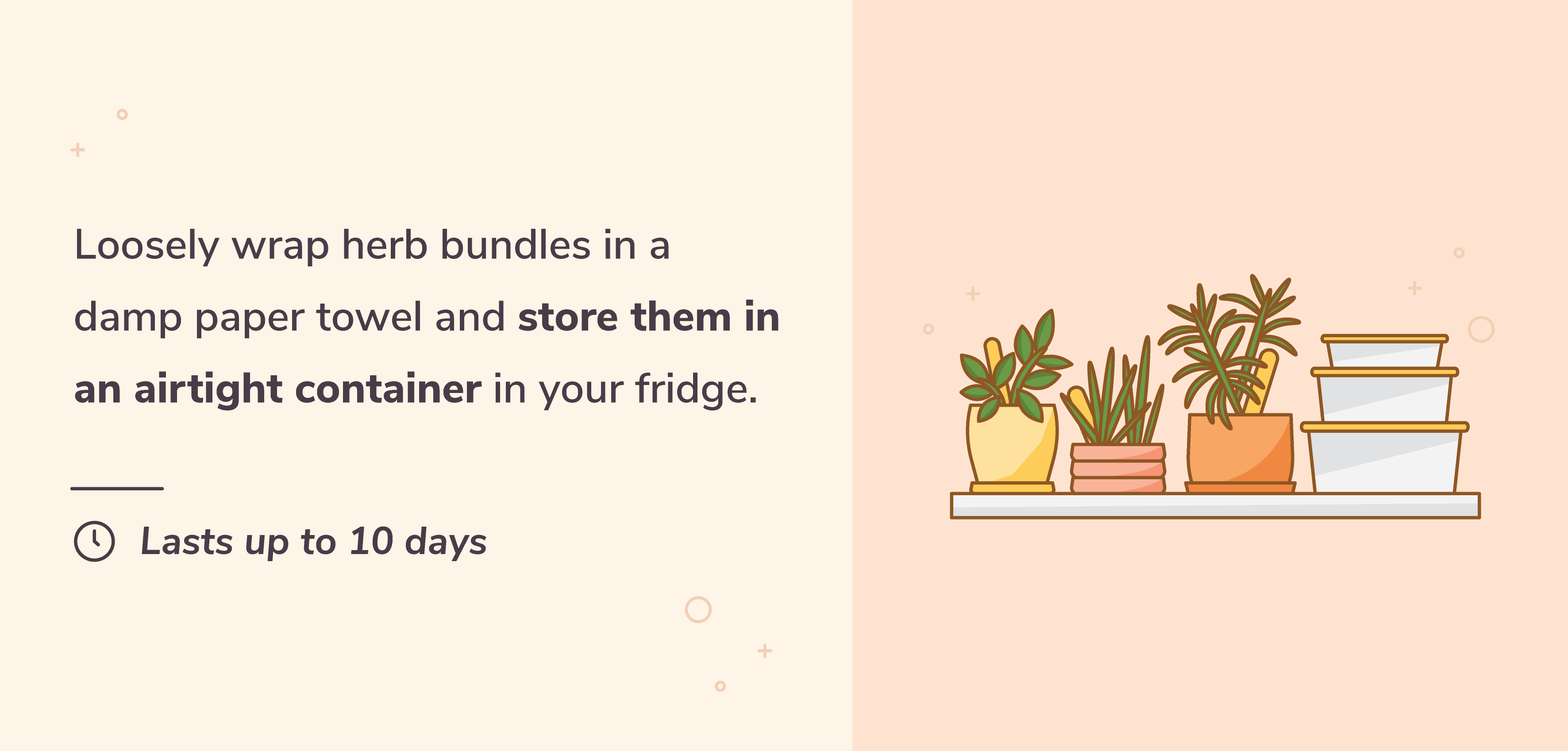
The best way to store bundles of fresh herbs is to loosely wrap them in a damp paper towel and place them in an airtight container or bag in your crisp drawer. This way, the herbs get just enough moisture so they won't dry out and won't get moldy due to too much oxygen. Herbs can last up to 10 days like this.
If your kitchen space allows it, keep more room in your fridge by creating an indoor herb garden! Fresh herbs like rosemary, basil, or chives can elevate the most basic dishes and will leave an aromatic scent in the air.
Benefits Of Buying Seasonal Produce
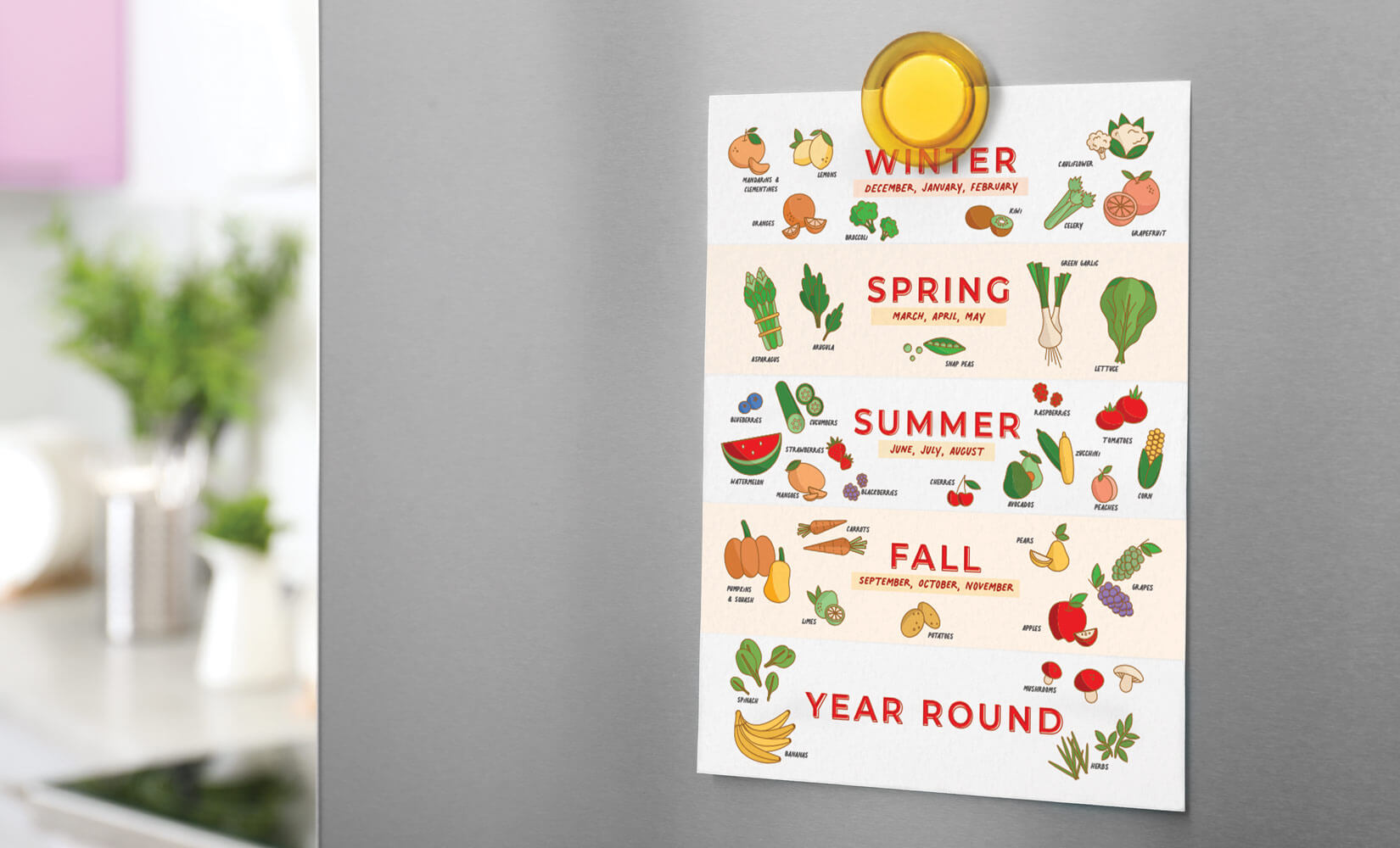
Buying and eating produce that is locally grown and in season has many benefits. Because they're fresh from the harvest and didn't have to sit in storage during a long transport, seasonal fruits and vegetables generally taste better, are more nutritious, and more affordable.
Besides getting the most out of your produce at the lowest cost, you're also supporting local farmers and minimizing your carbon footprint. Depending on where you live, there may be certain produce that's never locally grown in your area, but it can still help to know when it's in season elsewhere to get the freshest and most nutritious food.
Download our seasonal produce guide and pin it on your fridge or cabinets so you always know which foods are in season.
How To Store Produce FAQs
If there are still some unanswered questions that you have about properly storing produce, check out our answers below!
What is the best way to store produce?
Most produce is best stored in a paper or mesh bag. Whether you store it in the fridge (like apples, lettuce, or zucchini) or in the basement (like potatoes), it will keep the produce separate from other fruits and vegetables and still allow airflow which is essential to prevent mold.
What fruits should not go in the fridge?
Any fruit that continues to ripen after harvest (pears, peaches, kiwis, tomatoes, etc.) should be stored at room temperature. Only when they're fully ripe, you can keep them in the fridge to make them last a couple of days longer.
How can I make my produce last longer?
Generally speaking, produce will last longer in the fridge, however, some produce like tomatoes will lose their flavor when they get too cold. It's always best to buy produce fresh and consume it quickly. If you bought too much, try freezing your produce.
What produce should be refrigerated?
Any produce that is fully ripe and not a root vegetable or allium (onions, garlic, etc.) should be stored in the fridge to prolong the lifetime. Root vegetables and allium will harden and lose their flavor when they get too cold. It's better to store them in a dark, dry, and cool place like your basement or garage.
We hope this guide helps you buy produce that's in season and keep it fresh for longer. Besides the money you can save by properly storing your food, it's also a more environmentally friendly way of life as less wasted food means less strain on valuable resources like water and farmland. If you're looking to keep other groceries fresh for longer as well, check out our guide on how long it takes for popular foods to spoil.
Sources: Better Health Channel | The Kitchn | Fresh Direct | Seasonal Food Guide























